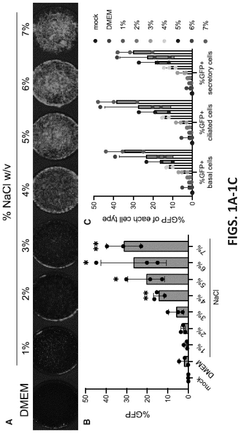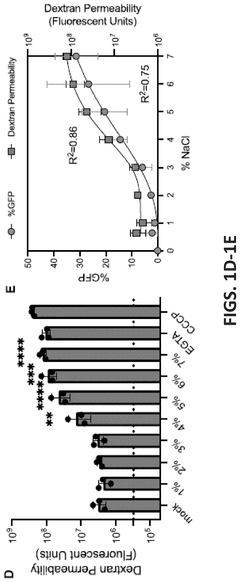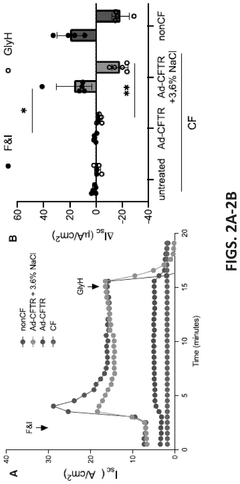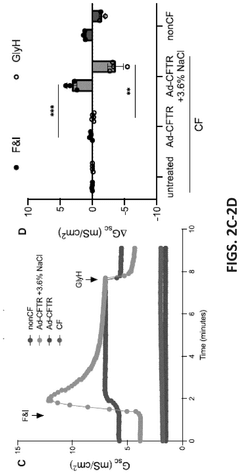Hypertonic Techniques: Innovations in Cellular Therapies
Hypertonic Techniques Evolution and Objectives
Hypertonic techniques have emerged as a promising frontier in cellular therapies, revolutionizing the field of regenerative medicine. The evolution of these techniques can be traced back to the early 2000s when researchers first began exploring the effects of hyperosmotic environments on cell behavior. Initially, the focus was primarily on understanding the cellular response to osmotic stress, but as the potential applications became apparent, the field rapidly expanded.
The primary objective of hypertonic techniques in cellular therapies is to enhance the efficacy and safety of cell-based treatments. By manipulating the osmotic environment, researchers aim to improve cell survival, proliferation, and functionality. This approach has shown particular promise in areas such as stem cell therapy, tissue engineering, and immunotherapy.
Over the past decade, significant advancements have been made in understanding the mechanisms underlying cellular responses to hypertonic conditions. These insights have led to the development of more sophisticated and targeted approaches. For instance, researchers have discovered that controlled exposure to hypertonic solutions can activate specific signaling pathways, leading to improved cell survival and function.
One of the key milestones in the evolution of hypertonic techniques was the realization that osmotic stress could be harnessed to enhance cell preservation during cryopreservation. This breakthrough has had far-reaching implications for the storage and transport of cellular therapies, addressing a critical challenge in the field.
Recent technological trends in hypertonic techniques include the development of smart osmotic agents that can respond to specific cellular cues, allowing for more precise control over the osmotic environment. Additionally, there has been a growing interest in combining hypertonic approaches with other advanced technologies, such as microfluidics and nanotechnology, to create more sophisticated and effective cellular therapies.
Looking ahead, the objectives for further advancement in hypertonic techniques are multifaceted. Researchers are working towards developing standardized protocols for applying hypertonic conditions in various cellular therapy applications. There is also a push to create more biocompatible and cell-specific osmotic agents that can minimize potential side effects while maximizing therapeutic benefits.
Another important goal is to elucidate the long-term effects of hypertonic treatments on cellular function and genetic stability. This knowledge is crucial for ensuring the safety and efficacy of hypertonic-based cellular therapies in clinical applications. Furthermore, there is a growing emphasis on translating laboratory findings into practical, scalable solutions that can be readily adopted in clinical settings.
Cellular Therapy Market Analysis
The cellular therapy market has experienced significant growth in recent years, driven by advancements in biotechnology and increasing demand for innovative treatments for various diseases. This market segment encompasses a wide range of therapies, including stem cell treatments, CAR-T cell therapies, and other engineered cellular products. The global cellular therapy market was valued at approximately $7.8 billion in 2020 and is projected to reach $23.5 billion by 2028, growing at a compound annual growth rate (CAGR) of 14.5% during the forecast period.
One of the key factors driving market growth is the rising prevalence of chronic diseases such as cancer, cardiovascular disorders, and autoimmune conditions. Cellular therapies offer promising treatment options for these complex diseases, often providing targeted and personalized approaches that traditional therapies cannot match. The increasing aging population worldwide also contributes to market expansion, as older individuals are more susceptible to age-related diseases that may benefit from cellular therapies.
The oncology segment dominates the cellular therapy market, accounting for the largest share of revenue. This is primarily due to the success of CAR-T cell therapies in treating certain types of blood cancers. The approval of several CAR-T cell products by regulatory agencies has paved the way for further research and development in this area, leading to a robust pipeline of potential new treatments.
Geographically, North America holds the largest market share, followed by Europe and Asia-Pacific. The United States, in particular, leads in cellular therapy research and development, with numerous clinical trials underway and a supportive regulatory environment. However, the Asia-Pacific region is expected to witness the fastest growth in the coming years, driven by increasing healthcare expenditure, improving research infrastructure, and growing awareness of advanced therapies.
Despite the promising outlook, the cellular therapy market faces several challenges. High treatment costs, complex manufacturing processes, and stringent regulatory requirements pose significant barriers to market entry and widespread adoption. Additionally, concerns about long-term safety and efficacy of some cellular therapies continue to impact market growth.
Emerging trends in the cellular therapy market include the development of allogeneic (off-the-shelf) therapies, which could potentially reduce costs and improve accessibility. There is also growing interest in combining cellular therapies with other treatment modalities, such as gene editing technologies, to enhance therapeutic outcomes. As research in hypertonic techniques and other innovations in cellular therapies progresses, it is likely to further expand the market potential and open new avenues for treatment across various disease areas.
Hypertonic Challenges in Cell Manipulation
Hypertonic techniques in cellular therapies present significant challenges in cell manipulation, primarily due to the delicate nature of cellular structures and their sensitivity to osmotic changes. The primary obstacle lies in maintaining cell viability and functionality while subjecting them to hypertonic conditions. Cells exposed to hypertonic environments experience rapid water loss, leading to cell shrinkage and potential damage to cellular components.
One of the key challenges is the precise control of osmolarity during the manipulation process. Achieving the right balance between creating an effective hypertonic environment and preventing irreversible cellular damage requires sophisticated monitoring and adjustment systems. This becomes particularly complex when dealing with heterogeneous cell populations, as different cell types may respond variably to hypertonic stress.
Another significant hurdle is the potential for long-term cellular alterations induced by hypertonic exposure. Even if cells survive the immediate effects of hypertonicity, there may be lasting impacts on gene expression, protein function, and cellular metabolism. These changes could potentially affect the therapeutic efficacy of manipulated cells, especially in applications such as stem cell therapies or engineered T-cell treatments.
The challenge of scalability also presents itself in hypertonic cell manipulation techniques. While procedures may be optimized for small-scale laboratory settings, translating these methods to large-scale clinical production introduces additional complexities. Maintaining consistent hypertonic conditions across larger volumes and ensuring uniform cellular responses become increasingly difficult as the scale of operation grows.
Furthermore, the integration of hypertonic techniques with other cell manipulation methods poses a significant challenge. For instance, combining hypertonic treatments with genetic modification procedures or cell purification techniques requires careful consideration of the cumulative stress on cells and potential interactions between different manipulation strategies.
Lastly, there is the challenge of developing standardized protocols for hypertonic cell manipulation that can be reliably reproduced across different research and clinical settings. The variability in equipment, reagents, and environmental conditions between laboratories can lead to inconsistent results, hampering the widespread adoption and validation of hypertonic techniques in cellular therapies.
Current Hypertonic Solutions in Cell Therapy
01 Hypertonic solutions for medical treatments
Hypertonic solutions are used in various medical treatments, including wound healing, reducing edema, and improving circulation. These solutions have a higher solute concentration than body fluids, creating an osmotic gradient that draws fluid out of tissues. This technique is particularly useful in treating conditions such as cerebral edema and managing intracranial pressure.- Hypertonic solutions for medical treatments: Hypertonic solutions are used in various medical treatments, including wound healing, reducing edema, and improving circulation. These solutions have a higher solute concentration than body fluids, creating an osmotic gradient that draws fluid out of tissues. This technique is applied in different medical fields, such as ophthalmology, dermatology, and emergency medicine.
- Hypertonic techniques in cell preservation and cryopreservation: Hypertonic solutions are employed in cell preservation and cryopreservation processes. These techniques involve using high concentrations of solutes to dehydrate cells before freezing, reducing the formation of damaging ice crystals. This approach is crucial in preserving various biological materials, including stem cells, tissues, and organs for research and medical applications.
- Hypertonic saline therapy for respiratory conditions: Hypertonic saline solutions are used in the treatment of respiratory conditions, particularly in patients with cystic fibrosis and bronchiectasis. The inhalation of hypertonic saline helps to improve mucociliary clearance, reduce airway inflammation, and enhance lung function. This technique is often combined with other therapies to manage chronic respiratory diseases.
- Hypertonic techniques in food preservation and processing: Hypertonic solutions are utilized in food preservation and processing techniques. This includes osmotic dehydration, where foods are immersed in hypertonic solutions to remove water and increase shelf life. The method is applied to fruits, vegetables, and meats, often in combination with other preservation techniques such as drying or freezing.
- Hypertonic techniques in biotechnology and fermentation: Hypertonic environments are employed in biotechnology and fermentation processes to manipulate cellular behavior and metabolic pathways. This includes techniques for enhancing the production of certain metabolites, improving stress tolerance in microorganisms, and optimizing fermentation conditions for various industrial applications, such as the production of biofuels and pharmaceuticals.
02 Hypertonic preservation techniques for biological materials
Hypertonic solutions are employed in preserving biological materials such as cells, tissues, and organs. The high solute concentration helps maintain cellular integrity during storage and transportation. This technique is crucial in fields like transplantation medicine and biobanking, where long-term preservation of biological samples is essential.Expand Specific Solutions03 Hypertonic techniques in food processing and preservation
In the food industry, hypertonic techniques are used for dehydration, preservation, and flavor enhancement. By immersing foods in hypertonic solutions, water is drawn out, reducing microbial growth and extending shelf life. This method is commonly applied to fruits, vegetables, and meats, and can also be used to create novel textures and flavors in food products.Expand Specific Solutions04 Hypertonic solutions in drug delivery systems
Hypertonic techniques are utilized in developing advanced drug delivery systems. The osmotic pressure created by hypertonic solutions can be harnessed to control the release of drugs from various formulations. This approach is particularly useful for sustained-release medications and targeted drug delivery, improving therapeutic efficacy and patient compliance.Expand Specific Solutions05 Environmental applications of hypertonic techniques
Hypertonic techniques find applications in environmental remediation and water treatment. These methods can be used for desalination, removal of contaminants from water bodies, and soil remediation. The osmotic pressure differential created by hypertonic solutions helps in separating pollutants from water or soil matrices, offering eco-friendly solutions for environmental challenges.Expand Specific Solutions
Key Players in Hypertonic Cellular Therapies
The field of hypertonic techniques in cellular therapies is in a dynamic growth phase, with significant market potential driven by increasing demand for advanced medical treatments. The global market for cellular therapies is expanding rapidly, estimated to reach billions of dollars in the coming years. Technologically, the field is progressing from experimental to more established applications, with varying levels of maturity across different therapeutic areas. Key players like Sanofi, Abbott Cardiovascular Systems, and Janssen Biotech are advancing commercial applications, while academic institutions such as Duke University and Carnegie Mellon University are pushing the boundaries of research. Collaborations between industry and academia, exemplified by partnerships involving companies like Lonza Ltd. and universities, are accelerating innovation and clinical translation in this promising field.
Sanofi
Immunolight LLC
Breakthrough Hypertonic Technologies
- The use of a hypertonic solution, specifically a hypertonic salt solution with a salt concentration ranging from about 1% to 8%, is introduced to enhance the delivery of gene therapy vectors by contacting cells with it before, after, or simultaneously with the vectors, thereby improving gene transfer efficiency.
- The development of self-assembled, micropatterned, and radio frequency (RF) shielded biocontainers that can be folded from two-dimensional precursors into three-dimensional polyhedral shapes with a fillable center chamber, allowing for the encapsulation and remote controlled release of therapeutic agents, and can be tracked non-invasively using magnetic resonance imaging.
Regulatory Framework for Cellular Therapies
For hypertonic techniques in cellular therapies, the regulatory pathway often falls under the category of Human Cells, Tissues, and Cellular and Tissue-Based Products (HCT/Ps). Depending on the specific application and level of manipulation, these therapies may be regulated as biologics, requiring a Biologics License Application (BLA), or as minimally manipulated HCT/Ps under Section 361 of the Public Health Service Act.
The European Medicines Agency (EMA) has established a similar framework for Advanced Therapy Medicinal Products (ATMPs), which includes cell therapies. The Committee for Advanced Therapies (CAT) within the EMA provides scientific recommendations on ATMP classifications and evaluates the quality, safety, and efficacy of these products.
Globally, regulatory bodies are working to harmonize their approaches to cellular therapy regulation. The International Conference on Harmonisation of Technical Requirements for Registration of Pharmaceuticals for Human Use (ICH) has developed guidelines that address quality, safety, and efficacy aspects of cellular therapies, which many countries have adopted or referenced in their regulatory frameworks.
Key regulatory considerations for hypertonic techniques in cellular therapies include product characterization, potency assays, stability testing, and manufacturing process validation. Regulatory agencies typically require extensive preclinical data and well-designed clinical trials to demonstrate safety and efficacy before granting market approval.
As the field of cellular therapies rapidly advances, regulatory frameworks are continuously adapting. Agencies are implementing expedited review pathways, such as the FDA's Regenerative Medicine Advanced Therapy (RMAT) designation, to facilitate the development of promising therapies for serious conditions. Additionally, regulatory bodies are increasingly focusing on post-market surveillance and long-term follow-up studies to ensure the ongoing safety and efficacy of cellular therapies.
The regulatory landscape for hypertonic techniques in cellular therapies also encompasses ethical considerations, particularly regarding the sourcing of cells and tissues. Regulatory frameworks often include provisions for donor screening, informed consent, and traceability to ensure ethical practices throughout the development and application of these innovative therapies.
Safety and Efficacy Considerations
The safety profile of hypertonic techniques must be thoroughly evaluated to ensure minimal risk to patients. One primary concern is the potential for cellular damage due to osmotic stress. Rapid changes in cell volume can lead to membrane disruption, protein denaturation, and alterations in intracellular ion concentrations. Researchers must carefully optimize protocols to balance the desired therapeutic effects with the maintenance of cell viability and function.
Long-term effects of hypertonic exposure on cellular behavior and genetic stability are also critical areas of investigation. Studies have shown that osmotic stress can induce changes in gene expression patterns and epigenetic modifications. These alterations may have implications for the long-term safety and efficacy of cellular therapies, necessitating comprehensive follow-up studies to monitor treated cells and patients over extended periods.
Efficacy considerations for hypertonic techniques in cellular therapies are multifaceted. The primary goal is to enhance the therapeutic potential of cells, whether through improved delivery, increased survival, or enhanced function. Researchers must demonstrate that hypertonic treatment leads to measurable improvements in clinical outcomes compared to conventional approaches.
One key aspect of efficacy is the consistency and reproducibility of hypertonic treatments. Standardization of protocols across different cell types and therapeutic applications is essential for widespread adoption. This includes optimizing factors such as osmolarity levels, exposure times, and recovery periods to achieve maximal therapeutic benefit while minimizing adverse effects.
The impact of hypertonic techniques on cell potency and differentiation potential is another critical consideration. For stem cell-based therapies, it is crucial to ensure that hypertonic treatment does not compromise the cells' ability to differentiate into desired lineages or maintain their multipotency. Extensive in vitro and in vivo studies are necessary to characterize these effects across various cell types and therapeutic applications.
Regulatory considerations play a significant role in the development of hypertonic techniques for cellular therapies. Regulatory agencies require robust preclinical and clinical data demonstrating both safety and efficacy before approving new therapeutic approaches. Developers must work closely with regulatory bodies to establish appropriate endpoints and study designs that adequately address the unique aspects of hypertonic cellular therapies.



